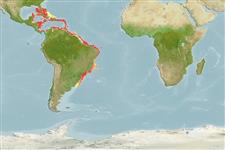Common names from other countries
Elasmobranchii (haaien en roggen) (sharks and rays) >
Carcharhiniformes (Ground sharks) >
Carcharhinidae (Requiem sharks)
Etymology: Rhizoprionodon: rhiza (Gr.), root; prion (Gr.) saw; odon (Gr.), tooth, referring to teeth with serrated (saw-like) bases, or roots [replacement name for Rhizoprion Ogilby 1915, preoccupied by Rhizoprion Jourdan 1861 in mammals]. (See ETYFish); porosus: Latin for pored or full of holes, referring to enlarged hyomandibular pores on both sides of head. (See ETYFish).
More on author: Poey.
Environment: milieu / climate zone / depth range / distribution range
Ecologie
marien; zoet water; brak water rifbewoner; diepte ? - 500 m (Ref. 244), usually ? - 100 m (Ref. 244). Tropical; 28°N - 40°S, 88°W - 32°W (Ref. 55194)
Western Atlantic: Caribbean, including the Bahamas, south to Uruguay. The separation of this species from Rhizoprionodon terraenovae whether as a distinct species or a representative of a southern subspecies is still uncertain and pending until detailed studies are commenced.
Lengte bij maturiteit / Grootte / Gewicht / Leeftijd
Maturity: Lm 65.0, range 80 - ? cm
Max length : 113 cm TL mannelijk / geslacht onbekend; (Ref. 111958); common length : 75.0 cm TL mannelijk / geslacht onbekend; (Ref. 5217); max. gepubliceerd gewicht: 7.5 kg (Ref. 111958)
Common in bays and estuaries often entering rivers. Also found in offshore waters at depths of about 500 m, generally less than 100 m. Feeds mainly on small bony fishes, including wrasses, but also marine snails, squid and shrimp. Viviparous, with 2 to 6 young in a litter. Size at birth about 31 to 39 cm. Utilized salted or frozen for human consumption and processed into fish meal. Not dangerous (Ref. 9710).
Distinct pairing with embrace (Ref. 205). Viviparous, placental (Ref. 50449).
Compagno, L.J.V., 1984. FAO Species Catalogue. Vol. 4. Sharks of the world. An annotated and illustrated catalogue of shark species known to date. Part 2 - Carcharhiniformes. FAO Fish. Synop. 125(4/2):251-655. Rome: FAO. (Ref. 244)
Status op de Rode Lijst van het IUCN (Ref. 130435)
Gevaar voor de mens
Harmless
Gebruik door de mens
Visserij: commercieel
Meer informatie
ReferentiesAquacultuurAquacultuurprofielKweeklijnenGeneticaElectrophoresesErfelijkheidZiektesVerwerkingMassaconversie
Tools
Speciale rapporten
Download XML
Internetbronnen
Estimates based on models
Preferred temperature (Ref.
115969): 17.5 - 27.1, mean 24.2 (based on 80 cells).
Fylogenetische diversiteitsindex (Ref.
82804): PD
50 = 0.5078 [Uniqueness, from 0.5 = low to 2.0 = high].
Bayesian length-weight: a=0.00214 (0.00141 - 0.00323), b=3.09 (2.97 - 3.21), in cm Total Length, based on LWR estimates for this species & Genus-body shape (Ref.
93245).
Trofisch niveau (Ref.
69278): 4.0 ±0.2 se; based on diet studies.
Weerstandsvermogen (Ref.
120179): Zeer laag, minimale populatieverdubbelingstijd meer dan 14 jaar (Fec=2; K=0.3-0.42).
Fishing Vulnerability (Ref.
59153): Moderate to high vulnerability (51 of 100).
